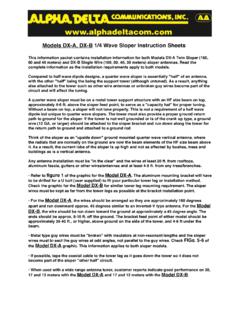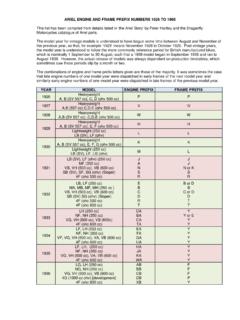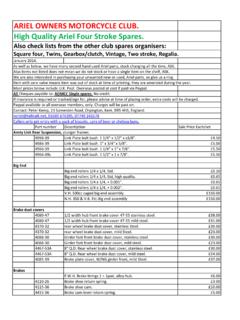Transcription of Sloper vs Inverted-V - Designerweb
1 Which is Better--The Quarter Wave Sloper or the Inverted-V Dipole?A paper by Alpha Delta Communications, A question that seems to be asked nearly everyday is, which is best, the quarter wave Sloper or the Inverted-V dipole ? But, a check of the literature and internet sites reveals very little definitive data. There is a lot of information on propagation, sunspot cycles, wave angles, DX performance, height above ground and data on yagi (beam) antenna stacking. Including which beam heights are best for certain band openings on given bands and propagation conditions. However, little of it relates to quarter wave slopers vs. Inverted-V dipoles. It is obvious of course that an incoming wave impinges on ANY antenna in its path, whether it s a beam, dipole, mobile whip, vertical or the proverbial wet noodle ! Also, the characteristics of this wave (elevation angle/polarization) change by the minute, hour, season, global location of the transmitting station from your site (distance) and the sunspot cycle, with regard to which antenna design and site/height above ground is favored at a given moment.
2 It continuously changes. This is true regardless of which antenna type you re phenomena is best stated in the 19th edition of the ARRL Antenna Book, Chapter 23, page 25. You should always remember that it is the ionosphere that controls the elevation angles, not the transmitting antenna. The elevation response of a particular antenna only determines how strong or weak a particular signal is, at whatever angles (or angles) the ionosphere is supporting at that particular instant for that propagation path and for that frequency .The foregoing is worth thinking about seriously because in a few words it explains some of the unexplainable frustrations about why your antenna seems better or worse than your friend s across town at a given time/band, or with the other antenna you just put up. It also reveals why certain antenna heights and designs are not always best for various conditions, bands and distances. In other words, neither the highest nor the lowest height is always best for all signals.
3 A single antenna can t do that! The old belief the highest is best does not always hold true. It is variable for all the reasons stated above. Now don t get us wrong---we re not saying a horizontal antenna 6 to 10 feet off the ground will ever work particularly well. We re talking about reasonable heights on a given band as discussed in the antenna Conditions for our Quarter Wave Sloper vs Inverted-V DipoleBecause of the above stated variables we wanted to test these antennas over the period of many months through different seasons. Indeed, we found that propagation Page 2conditions change as predicted. Our Alpha Delta antenna test site is on a small mountain ridge at 5500 feet above sea level in central Arizona. It is fairly free of surrounding objects except for some Ponderosa pines. The distant horizon can be seen for almost 360 degrees. The ground slopes down for several hundred feet and out for several miles in the antennas were mounted at a height of 40 feet, not because this is optimum, but because it represents a typical home type installation for many hams.
4 The Sloper was an Alpha Delta Model DX-B quarter wave Sloper (sloping to the north) and the Inverted-V was a model DX-DD dipole (broadside north and south)---typical of a home based station. We used 80 and 40 meters since those are the most difficult bands for the average ham with a modest station to work DX. It does not represent the height of a big gun or contest type station because most hams don t have that. Those heights and installations are in a whole different testing any two antennas, there are several things that must be taken into account for the tests to be meaningful. The antennas must be tuned to the same portion of the band, or one will be down compared to the other. They must be oriented so one is not in the field of the other. At the same time, differences in directivity must be taken into account. Not an easy task! In the real world, there will be some interaction, but it must be held to a minimum.
5 Also, quarter wave (half slopers) slopers have very unique installation requirements that must be followed. Check our Web site for that. (Also Chapter 6, pages 30-31, 19th edition ARRL Antenna Book). Because we wanted to simulate the typical ham environment, we used s meter results and transmitting results from various stations. S meters are the most meaningful to many hams because that s what they re used to. Also, we switched antennas using a Model DELTA-4C coaxial switch console. Hams typically don t have lab gear. Sure, s meters are relatively inaccurate and results vary with QSB and the subjective comments of others. However, over a long period of time (months, years), comparative results will reveal themselves. Antenna purists will have a fit, but this paper is not directed to them. (We know the tech stuff too).Test Results for the Sloper vs Inverted-V Dipole on 80/40 metersSlopers are generally known to be good low angle DX antennas, while the Inverted-V dipole is generally known to respond to higher angle, regional type signals.
6 This is particularly true at our fairly low 40 foot test height. In order to select the better antenna for your particular needs, you need to consider asking the following Page 3three questions. 1. Where you want to talk (distance)? 2. In what direction? 3. At what time of day?Here is where some unplanned and very interesting results unfolded. From our test site, the Inverted-V beat the Sloper ( with a few exceptions) all the way across the by one to two s units. What we didn t expect was it also beat the Sloper into the Caribbean area as evidenced by many stations in the CQ WW SSB contest during October, 2001(local evening operation). It shows that the higher incoming wave angles from there and the were favoring the response of the Inverted-V . As stated earlier, these wave angles will change based on time of day and distance. You ll see this when we get into DX results vs time of before and during local sun up, many Japan, China and Pacific stations were logged and worked.
7 Here was another surprising result---the Sloper this time was exactly the same as the Inverted-V . It turns out the incoming signals were multi-hop higher angle signals apparently favoring both antennas equally. During the same period, Caribbean stations were better on the V as before. We could tell it was multi-hop because we could hear and work closer-in Pacific stations who were working the same Asian stations. As further evidence, a Hawaiian station confirmed both our antennas were the same strength at that sundown and into the evening, things changed dramatically in favor of the Sloper . Low angle incoming signals from Europe, Africa and Asian Russia were favoring the characteristics of the Sloper ---by a wide enough margin to sometimes make the difference of hearing them or not, and the ability to work them. It was fascinating to watch stations from Europe through north Africa kick the s meter up a full s unit in favor of the Sloper .
8 This was a big difference in weak signal, noisy conditions, and was consistent with stations in Belgium, Russia, north Africa, Spain. Portugal, Poland, Finland, France and particularly EA9LZ in Spanish Sahara. He was worked with ease with the Sloper showing a consistent 5 dB improvement over the V. The foregoing results were similar on both 40 and 80 meters during the same times of pointed out in Chapter 6 of the ARRL Antenna Book referenced above, slopers are known to have some directivity in the direction of the down slope with a broad pattern. We observed this with stations in Australia who reported better performance with the V. Australia is pretty much off the back of the Sloper . When DX stations were within the pattern of the Sloper , the Sloper was always the same or better than the V as pointed out have used the DX contest because it s a convenient example. However, the important thing to know is these results track accurately with our long term comparisons and 4As a result of our research, the next thing to decide is whether you have the room to put up and use both antenna types.
9 If you have a tower with a beam on it and some room in the back yard, it shouldn t be too difficult to do. An Inverted-V only requires a single support, as does the Sloper . This will add a great deal of versatility to your station. Conclusions and BibliographyEven with the exceptions that do occur in antenna testing due to the capricious nature of the ionosphere, there are long term feelings derived from testing these antennas. These feelings are found to be fairly consistent over time. Remembering that the antennas at our test site were only 40 feet high we came to these conclusions:A. Quarter wave slopers are excellent DX antennas when dealing with long haul, low angle signals (typically beyond 3000 miles), and can often make the difference in working a weak DX station. Keep in mind that a Sloper is small, being only half the length of a half wave dipole and is easy to install. However, their unique installation requirements must be adhered to with references as stated in this paper.
10 Even with certain higher wave angles, they will keep up with the The Inverted-V half wave dipole is an excellent all around antenna, doing its best work at higher installation heights (40 to 60 feet, or higher). Its response to high incoming wave angles is such that its performance for stateside type distances (out to approximately 2500 miles) is excellent. Its directivity at 40 feet didn t seem quite as noticeable as stations off the back of the Sloper . C. Keep in mind that the conditions of the ionosphere can change instantaneously favoring a different antenna design at a given moment. It hasbeen said many times, there is no one best antenna, no one best antenna height for all conditions during all seasons and all periods of the sunspot cycle. This is what makes antenna experimentation so much fun, and brings so much enjoyment to the stations, stateside and DX, were logged and worked over the months during this testing.







